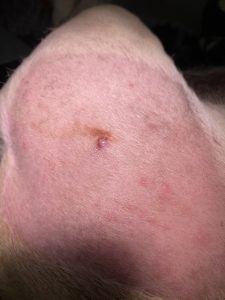The importance of checking skin lumps
By Kay Hisano | Dated April 29, 2024
Lumps can present on dogs and cats in all sorts of ways: some small, some on the face, some hairless, and some dark in color. Not all lumps are malignant, but regardless of what the lump looks like, it is always a good idea to have it checked by a vet. Often, when a new lump is found, your veterinarian will ask you a couple of questions about it: How long has it been there? Is it quickly growing? Is your pet bothered by it? All these questions are helpful in figuring out what the lump is.
Another important diagnostic tool that a veterinarian will carry out is a fine needle aspirate (FNA). This is when a small needle is used to extract cells from a suspicious lump, which are then examined under a microscope. An FNA can sometimes be enough to diagnose exactly what the lump is, but more often than not, a biopsy may be needed. During a biopsy, a small section or the entire lump is removed and sent to the pathologist for diagnosis.
Biscuit presented to Gordon Vet for a new small lump that the owner found on her back. The lump itself was only about 2-3mm in size.

Biscuit’s Small Lump
Biscuit previously had a Mast Cell Tumour (MCT) removed, and Dr. Scott was worried that a new MCT had grown. Dr. Scott carefully placed a small needle into the lump to collect some cell samples and was able to indeed confirm that it was an MCT. The following week, Biscuit had surgery to get the MCT removed, and the MCT was sent off to the laboratory for further diagnosis and grading.
A Mast Cell Tumor (MCT) is a type of cancer that can affect dogs. MCTs can occur anywhere on or in the body and can vary in size, shape, and aggressiveness. MCTs can range from relatively benign to highly malignant, and their behavior can be unpredictable. Some may remain small and localized, while others can spread (metastasize) to other parts of the body, making early detection and treatment crucial for a better prognosis.
Treatment options for MCTs usually start with surgical excision, with wide margins. Further treatments can include radiation therapy, chemotherapy, or a combination of these approaches, depending on the tumor’s size, location, grade, and extent of spread.
Thankfully, Biscuit’s lump came back as a low-grade MCT, which means that it has an excellent prognosis with a low risk of metastasis. Almost three weeks post-surgery, Biscuit has recovered well from her surgery and is acting like nothing had happened.
